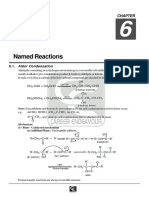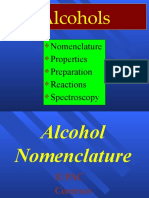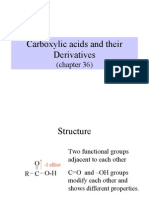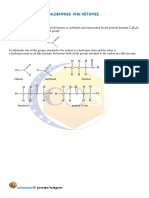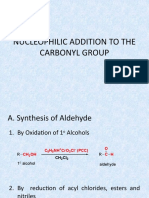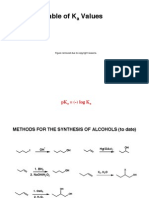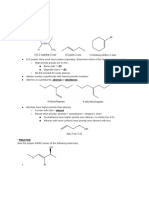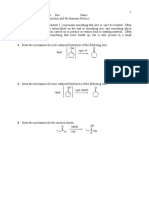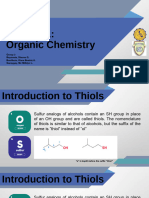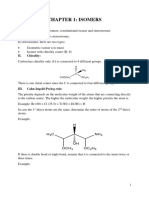ch17 Summary
ch17 Summary
Uploaded by
api-465421809Copyright:
Available Formats
ch17 Summary
ch17 Summary
Uploaded by
api-465421809Original Title
Copyright
Available Formats
Share this document
Did you find this document useful?
Is this content inappropriate?
Copyright:
Available Formats
ch17 Summary
ch17 Summary
Uploaded by
api-465421809Copyright:
Available Formats
Summary of CH17 Aldehydes and Ketones • Ketone/aldehyde protection as cyclic thioacetal (see VI above): stable to
I. Nomenclature base and H3O+, LiAlH4, RLi, RMgX, etc. (complementary to cyclic acetals)
• Common names • IUPAC name • vic-diol protection as cyclic acetals: stable to base, LiAlH4, RLi, RMgX, etc
II. Synthesis of aldehydes and ketones HO OH H+ R' O CH3
• Oxidation of alcohols (review section 8.6) CH3COCH3
R O CH3
R' R
PCC, CH2Cl2: 1° RCH2OH ––>RCHO
MnO2: allylic or benzylic C=CH–CH2OH ––> C=CH–CHO VIII. Addition of H-NH2 and its derivatives to form imines,
Jones reagent: 2° RR'CHOH ––>RR'C=O enamines, oximes, hydrazones, semicarbazones
• All additions are under acid catalysis.
• Ozonolysis of alkenes (review section 12.11) • Addition of H-HN2 or H-NHR (1° amine) to C=O forms imine
R1R2C=CHR3 ––>R1R2C=O (ketones) + R3CHO (aldehyde) R'
R' H+
• Hydration of alkynes (review section 13.8 & 13.9) R' = alkyl (ketone)
O H–NHR NR
R' = H (aldehyde)
(A) Markovnikov hydration to ketones, (B) anti-Markovnikov hydration to R R
aldehydes • Addition of H-NR1R2 (2° amine) to C=O containing -H forms enamine
1. R2BH
Hg2+, H2SO4, H2O O (B)R C CH RCH2 CHO
(A)R C CH 2. H2O2, HO– R' = alkyl (ketone) R' H+ R'
R CH3
R' = H (aldehyde) O H–NR2 NR''2
•Friedel-Crafts acylation (review section 15.14)
RCH2 RHC
O O
• Additions of H-NHOH, H-NHNHR, or NH2NHCONH2, H+form crystaline
CO, HCl, AlCl3 RCOCl, AlCl3
H R compounds that are often used in identifying unknown aldehydes or ketones
H–NHOH, H+ R'
S S S phenones R'
benzaldehydes N-OH oxime
III. General mechanisms for nucleophilic addition to C=O O R
R R'
• Nucleophilic addition-protonation (if Nu is a strong nucleophile
R' = alkyl (ketone) NH2NHR, H+ NNHR
and the reaction is under basic conditions)
R' = H (aldehyde) R hydrazone
H 2O R'
– O –
C O Nu OH
N-NHCONH 2
Nu Nu
+ R semicarbazone
NH2NHCONH 2, H
• Electrophilic protonation-addition (if Nu is a weak nucleophile and the
reaction is under acidic conditions) • Wolff-Kishner reduction: to reduce C=O to -CH2- under strong basic
H+ conditions
Nu– R' NH2NH2, NaOH, heat H
C O C OH OH R' = alkyl (ketone) R'
O C H
Nu R' = H (aldehyde) R
R
IV. Addition of H-OH to form hydrates Compare the C=O to –CH2-reduction by Wolf-Kishner reduction,
• Acid or base catalysis
Clemmensen reduction, or thioacetal-hydrogenolysis reactions and
• Reversible reaction with the equilibrium favoring aldehyde or ketone
R' their respective limitations.
R H+ or HO–
R' = alkyl (ketone) R IX. Addition of H-CN to form cyanohydrins
C O H 2O OH
R' = H (aldehyde) • Acid-catalyzed addition
R' HO hydrate • Cyanohydrins are versatile synthetic intermediates
V. Addition of H–OR to form acetals HCl RH2C – hydroxy acid
• Acid or base catalysis R'
O RH 2 C CO 2H
• Reversible reaction with the equilibrium favoring aldehyde or ketone H+ HO
R' R'
R H+ or HO– R' CN conc. H2SO4 –unsaturated
R' = alkyl (ketone) R R' CH2R RHC
C O O R'' OH HO acid
R' = H (aldehyde) CO2H
R' H R''O cyanohydrin
hemiacetal H–CN 1. LiAlH4 RH2C
R' –hydroxy
• 5– or 6– membered cyclic hemiacetals are favored and relatively stable 2. H2O CH2NH2 amine
R' = alkyl (ketone)
R H+ or HO– OH HO
cyclic X. Addition of phosphorus ylides: The Wittig reaction
R' = H (aldehyde) OH O O R hemiacetal
• Preparation of phosphorus ylides
• Hemiacetals are further converted into acetals under acidic conditions 1. P(C6H5)3, benzene RHC P(C6H5)3
RCH2X
R' H , + R' (1°, 2° alkyl halide)
2. strong base (ylide)
R O R'' R (RLi, NaH, or RONa/ROH)
hemiacetal OH OR''
R''O H • Synthesis of alkene from C=O compounds
R''O acetal
VI. Addition of H–SR to form thioacetals R' = alkyl (ketone) R' RHC P(C6H5)3 / THF R'
R' = H (aldehyde) O C RHC
• Thioacetal formation requires a Lewis acid catalyst such as BF3, or ZnCl2 R R
• Thioacetals are stable in H3O+ but can be hydrolyzed with a Lewis acid as XI. Addition of H–OOCOR: The Baeyer–Villiger oxidation
catalyst R BF3 or ZnCl2 R'
• Conversion of aldehydes (R'=H) to acids and ketones (R'=alkyl) to esters
R' = alkyl (ketone) R SR''
O
C O + 2 RSH O
R' = H (aldehyde) O
HgCl2, H2O, R''S thioacetal The migratory aptitude of R:
R' C R O OH, CH2Cl2
CH3CN C H > 3° > 2° > 1° > CH3
R' R
• Thioacetal formation - hydrogenolysis provides a method to reduce R' OR
C=O to -CH2– O HS XII. Oxidative chemical tests for aldehydes
Lewis acids S S
R' = alkyl (ketone) C H H • Fehling's test
R' = H (aldehyde) R' Raney Ni, H2
R R Cu2O (s)
R HS R' R Cu+, NaOH, H2O
R C O C O (brick red)
R'
VII. Acetals and thioacetals as protecting groups in synthesis H HO
• ketone/aldehyde protection as cyclic acetal: stable to base, LiAlH4, RLi, • Tollen's test
RMgX HO +
O H O O
R' = alkyl (ketone) Ag+
O O Ag (s)
R' = H (aldehyde) C cyclic acetal C NH3, H2O C (mirror)
R' R HO R' R R H R OH
You might also like
- GMP GR: Reaction Chart For AlkanesDocument3 pagesGMP GR: Reaction Chart For AlkanesManoj DesaiNo ratings yet
- Schaum's Easy Outline of Organic Chemistry, Second EditionFrom EverandSchaum's Easy Outline of Organic Chemistry, Second EditionRating: 3.5 out of 5 stars3.5/5 (2)
- Ca SynthDocument1 pageCa Synthapi-465421809No ratings yet
- Ca SynthDocument1 pageCa Synthapi-465421809No ratings yet
- Named Reactions: 6.1. Aldol CondensationDocument17 pagesNamed Reactions: 6.1. Aldol CondensationNikunja samalNo ratings yet
- List of Organic Reagents: I. Reducing AgentsDocument10 pagesList of Organic Reagents: I. Reducing AgentsJatin BhasinNo ratings yet
- Amino Acid and BiochemistryDocument10 pagesAmino Acid and BiochemistryUNKNOWNNo ratings yet
- Alcohols: Nomenclature Properties Preparation Reactions SpectrosDocument38 pagesAlcohols: Nomenclature Properties Preparation Reactions SpectrosjuvyneilNo ratings yet
- Chapter 8 Reactions of AlcoholsDocument12 pagesChapter 8 Reactions of AlcoholsRoberto SIlvaNo ratings yet
- Chapter 21 NotesDocument43 pagesChapter 21 NotesTiffany YehNo ratings yet
- CHEM120 Part 3Document34 pagesCHEM120 Part 3sibonginkosimagudulelaNo ratings yet
- Alkynes Medorg2Document6 pagesAlkynes Medorg2AR LazagaNo ratings yet
- Carboxylic AcidsDocument26 pagesCarboxylic Acidsapi-3734333100% (1)
- Heterocyclic Chemistry: Chapter 10:pyrroles, Reactions and SynthesisDocument30 pagesHeterocyclic Chemistry: Chapter 10:pyrroles, Reactions and SynthesisTaciturnoait NihilistaNo ratings yet
- Organic Chemistry New Gyan SutraDocument8 pagesOrganic Chemistry New Gyan SutraSatyam JaiswalNo ratings yet
- Mind Map (Hydrocarbons)Document3 pagesMind Map (Hydrocarbons)Meenakshi NairNo ratings yet
- 556611269 Mind Map HydrocarbonsDocument3 pages556611269 Mind Map Hydrocarbonsmedookasha009No ratings yet
- Aldehydes and KetonesDocument7 pagesAldehydes and KetonesA LEVEL TOPNo ratings yet
- Carboxylic Acids and Its Derivatives NotesDocument26 pagesCarboxylic Acids and Its Derivatives NotesAyush Gangwani50% (2)
- Aldehyde and KetoneDocument3 pagesAldehyde and KetoneErica TepepaNo ratings yet
- 04 Reactive IntermediatesDocument115 pages04 Reactive IntermediatesMuhammad ArsalanNo ratings yet
- Ex 1Document12 pagesEx 1iknowshivam74No ratings yet
- 65bc787665022d00198279d3 - ## - Amines Short NotesDocument7 pages65bc787665022d00198279d3 - ## - Amines Short NotesImdadullah AkbarNo ratings yet
- Amines : Short NotesDocument7 pagesAmines : Short Notesakosha.suruchiNo ratings yet
- Amines _ Short Notes __ Vijeta Series Class-12thDocument7 pagesAmines _ Short Notes __ Vijeta Series Class-12thSʜɪᴠᴀɴsʜNo ratings yet
- BeckmannDocument17 pagesBeckmannMaryam KhushbakhatNo ratings yet
- Hydrocarbon: Ashwani Tyagi Sir (Code: ATJEE)Document22 pagesHydrocarbon: Ashwani Tyagi Sir (Code: ATJEE)Prince DigvijayNo ratings yet
- Functional Group Transformation Using Sn2 ReactionDocument13 pagesFunctional Group Transformation Using Sn2 Reactionkurniatriwijaya.2410No ratings yet
- SynrxnsDocument48 pagesSynrxnsRonak MantriNo ratings yet
- Road Map Organic PDFDocument5 pagesRoad Map Organic PDFS Square100% (1)
- AminesDocument53 pagesAminesSUNNY FFNo ratings yet
- 5L ReductionsDocument20 pages5L ReductionsCarlos Javier Orellana OrtizNo ratings yet
- Winstein: Concept of Ion Pairs: Contact or Tight Ion PairDocument14 pagesWinstein: Concept of Ion Pairs: Contact or Tight Ion PairAnil Kumar100% (2)
- 2008 08 08-LAmbrosini-RitterDocument17 pages2008 08 08-LAmbrosini-RitteranantNo ratings yet
- Hydrocarbon 13 THDocument20 pagesHydrocarbon 13 THRaju SinghNo ratings yet
- Alkane: General Methods of Preparation: (1) by Catalytic Reduction of Alkenes and AlkynesDocument11 pagesAlkane: General Methods of Preparation: (1) by Catalytic Reduction of Alkenes and AlkynesaashishNo ratings yet
- HydrocarbonDocument94 pagesHydrocarbonArshNo ratings yet
- Aldehyde Ketones and Carboxylic Acids Notes - 240913 - 022315Document15 pagesAldehyde Ketones and Carboxylic Acids Notes - 240913 - 022315onaldoalseyNo ratings yet
- Hydrocarbon (12th)Document22 pagesHydrocarbon (12th)Raju SinghNo ratings yet
- Net Organic ChemistryDocument12 pagesNet Organic ChemistrystellaNo ratings yet
- Module3 PDFDocument130 pagesModule3 PDFaneeda shabirNo ratings yet
- NMRshifts1H GeneralDocument1 pageNMRshifts1H GeneralJeric CestinaNo ratings yet
- Aldehydes and KetonesDocument19 pagesAldehydes and KetonesVaibhav TarkasbandNo ratings yet
- Topic 16 Aldehydes, Ketones and Optical Isomerism Reactions of Aldehydes and Ketones Optical IsomerismDocument15 pagesTopic 16 Aldehydes, Ketones and Optical Isomerism Reactions of Aldehydes and Ketones Optical Isomerismclip215No ratings yet
- Haloalkanes and HaloarenesDocument26 pagesHaloalkanes and Haloarenesrajputrishi1982100% (1)
- Chemical Reactions of Cyanide and Isocyanide SummaryDocument1 pageChemical Reactions of Cyanide and Isocyanide SummaryAbhilasha SharmaNo ratings yet
- Nucleophilic Addition To The Carbonyl GroupDocument16 pagesNucleophilic Addition To The Carbonyl GroupYuni PurnamasariNo ratings yet
- HydrocarbonDocument36 pagesHydrocarbonUsha SherkhaneNo ratings yet
- (English) Nar Package Notes-1Document16 pages(English) Nar Package Notes-1sachingurja27No ratings yet
- Table of K ValuesDocument7 pagesTable of K ValuesdasoodaseeNo ratings yet
- Kap 12,13,17, IIDocument12 pagesKap 12,13,17, IImuraliNo ratings yet
- Carbonyl CompoundsDocument10 pagesCarbonyl CompoundsMahendra ChouhanNo ratings yet
- 65c4a6bfbcb81e001838a02d - ## - Carbonyl Compounds and Carboxylic Acid Short NotesDocument4 pages65c4a6bfbcb81e001838a02d - ## - Carbonyl Compounds and Carboxylic Acid Short Notesmrinmayghosh55535No ratings yet
- Adobe Scan 09-Nov-2024Document1 pageAdobe Scan 09-Nov-2024eslavathsushanth6No ratings yet
- Roadmap - Main Corrected 2013Document1 pageRoadmap - Main Corrected 2013Luân Chu Nguyễn NhậtNo ratings yet
- X UV Light or Heat: Reactions in Topic XIDocument3 pagesX UV Light or Heat: Reactions in Topic XImichelsonyip100% (1)
- CH 20-21 Answers (All)Document36 pagesCH 20-21 Answers (All)Thục NghiNo ratings yet
- Chapter 8 SlidesDocument63 pagesChapter 8 SlidespoojaNo ratings yet
- Alcohols Phenols and Ethers - 3Document31 pagesAlcohols Phenols and Ethers - 3saranjeeaspirant456No ratings yet
- Carboxylic Acid Derivatives - McMurryDocument39 pagesCarboxylic Acid Derivatives - McMurryPat FerrerNo ratings yet
- Benzene RxnsDocument1 pageBenzene Rxnsapi-465421809No ratings yet
- 118c Practice Synthesis KeyDocument18 pages118c Practice Synthesis Keyapi-465421809No ratings yet
- 118c Practice Synthesis KeyDocument18 pages118c Practice Synthesis Keyapi-465421809No ratings yet
- Phenol Rxns IDocument1 pagePhenol Rxns Iapi-465421809No ratings yet
- Phenol SynthDocument1 pagePhenol Synthapi-465421809No ratings yet
- Amide RxnsDocument1 pageAmide Rxnsapi-465421809No ratings yet
- Amine SynthDocument1 pageAmine Synthapi-465421809No ratings yet
- Ester RxnsDocument1 pageEster Rxnsapi-465421809No ratings yet
- Nitrile RxnsDocument1 pageNitrile Rxnsapi-465421809No ratings yet
- Acyl Halide RxnsDocument1 pageAcyl Halide Rxnsapi-465421809No ratings yet
- Anhydride RxnsDocument1 pageAnhydride Rxnsapi-465421809No ratings yet
- Ca Rxns IDocument1 pageCa Rxns Iapi-465421809No ratings yet
- Ca RXN CheckDocument1 pageCa RXN Checkapi-4654218090% (1)
- CH 17: Aldehydes and Ketones: Nasiri CHE118B Final Study Guide Spring 2019 - S. Ly Sdly@ucdavis - EduDocument17 pagesCH 17: Aldehydes and Ketones: Nasiri CHE118B Final Study Guide Spring 2019 - S. Ly Sdly@ucdavis - Eduapi-465421809No ratings yet
- 118b mt1 Study Guide 2Document21 pages118b mt1 Study Guide 2api-465421809No ratings yet
- ch18 SummaryDocument1 pagech18 Summaryapi-465421809No ratings yet
- Bond LinesDocument5 pagesBond Linesapi-465421809No ratings yet
- ch15-16 SummaryDocument1 pagech15-16 Summaryapi-465421809No ratings yet
- Chapter 16 Aldehydes and KetonesDocument95 pagesChapter 16 Aldehydes and KetonesXue XuNo ratings yet
- WWW Erowid OrgDocument14 pagesWWW Erowid Orgtny6331100% (1)
- Application of Schiff Base in Biology PDFDocument7 pagesApplication of Schiff Base in Biology PDFDadaNo ratings yet
- Name Eactions FinalDocument33 pagesName Eactions FinalAli Akand AsifNo ratings yet
- Chitosan Catalyzed Synthesis of IminesDocument6 pagesChitosan Catalyzed Synthesis of IminesaustingoewertNo ratings yet
- Schiff Base Metal Complexes Thesis PDFDocument7 pagesSchiff Base Metal Complexes Thesis PDFhan0fus1gij2100% (3)
- 000531876-EuropeanJournalOfOrganicChemistry Vol 1998 Issue 7 1271-1273 PDFDocument3 pages000531876-EuropeanJournalOfOrganicChemistry Vol 1998 Issue 7 1271-1273 PDFjohannes karcherNo ratings yet
- Chap 2Document108 pagesChap 2Irfan AzaharNo ratings yet
- Draw The Mechanism For Acid-Catalyzed Hydrolysis of The Following EnolDocument4 pagesDraw The Mechanism For Acid-Catalyzed Hydrolysis of The Following EnolGianella BonifasNo ratings yet
- Buchwald-Hartwig C-N Cross Coupling Reactions Catalyzed by A Pseudo-PincerDocument7 pagesBuchwald-Hartwig C-N Cross Coupling Reactions Catalyzed by A Pseudo-PincerAlberto ReyesNo ratings yet
- 5-Aldehydes Ketones 2019Document1 page5-Aldehydes Ketones 2019Mahesh ShahNo ratings yet
- Carbonyl CompoundsDocument97 pagesCarbonyl CompoundsAsif HodaNo ratings yet
- Glutaraldehyde Behavior in Aqueous Solution, Reaction With Proteins, and Application To Enzyme CrosslinkingDocument12 pagesGlutaraldehyde Behavior in Aqueous Solution, Reaction With Proteins, and Application To Enzyme CrosslinkingwardaninurindahNo ratings yet
- DIBAL - A Bulky Reducing Agent For EstersDocument13 pagesDIBAL - A Bulky Reducing Agent For EstersbbnchemNo ratings yet
- Reagents 2021 LETESTDocument134 pagesReagents 2021 LETESTSonu PrajapatiNo ratings yet
- Amines and ThiolsDocument103 pagesAmines and ThiolsKarla Joy P. SucgangNo ratings yet
- Aldehydes, Ketones and Carboxylic AcidsDocument45 pagesAldehydes, Ketones and Carboxylic AcidsKaran VermaNo ratings yet
- TM 2 Fundamentals of Organic Chemistry 7th Edition by John McMurryDocument15 pagesTM 2 Fundamentals of Organic Chemistry 7th Edition by John McMurrysukma AsaNo ratings yet
- Chapter 21 Ald KetonesDocument82 pagesChapter 21 Ald KetonesAndra Ch123No ratings yet
- LT HHCDocument74 pagesLT HHCtrangdoan.31221023445No ratings yet
- Aldehydes, Ketones and Carboxylic Acids: Module - 7Document29 pagesAldehydes, Ketones and Carboxylic Acids: Module - 7TeachingTrainingCoaching KnowledgeSharingSessionNo ratings yet
- Chitosan Schiff-Base Hydrogels-A Critical Perspective ReviewDocument11 pagesChitosan Schiff-Base Hydrogels-A Critical Perspective ReviewAlexandraNo ratings yet
- Amination (Organic Chemistry)Document9 pagesAmination (Organic Chemistry)Sara ShafiqNo ratings yet
- Synthesis and Characterization of Schiff Based LigandsDocument12 pagesSynthesis and Characterization of Schiff Based LigandsEthan HuntNo ratings yet
- 19 Enolates EnaminesDocument59 pages19 Enolates EnaminesFlowerNo ratings yet
- Ald Ketones II Ques 09Document39 pagesAld Ketones II Ques 09Chitrasen GuptaNo ratings yet
- Microwave-Mediated Synthesis of Lophine: W Developing A Mechanism To Explain A ProductDocument3 pagesMicrowave-Mediated Synthesis of Lophine: W Developing A Mechanism To Explain A ProductDannyNo ratings yet
- SAR of Benzodizepines by Dr.P.B. MohiteDocument20 pagesSAR of Benzodizepines by Dr.P.B. MohitePRITAM ACHARJYANo ratings yet
- 10 11648 J SJC 20180602 11 PDFDocument7 pages10 11648 J SJC 20180602 11 PDFAnonymous XDKzvvpFzzNo ratings yet
- Reactions of Synthetic ImportanceDocument28 pagesReactions of Synthetic ImportanceRx Nadeem ChhipaNo ratings yet




